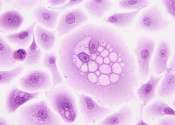Scientists identify 'immune cop' that detects SARS-CoV-2
Scientists at Sanford Burnham Prebys Medical Discovery Institute have identified the sensor in human lungs that detects SARS-CoV-2 and signals that it's time to mount an antiviral response. The study, published today in Cell ...
Jan 12, 2021
0
18








